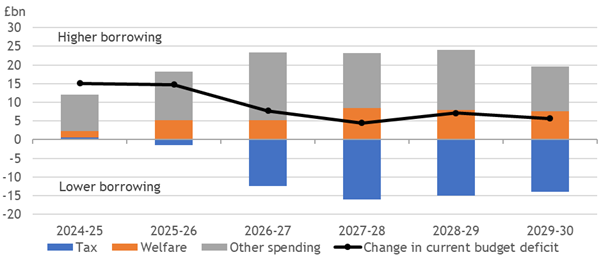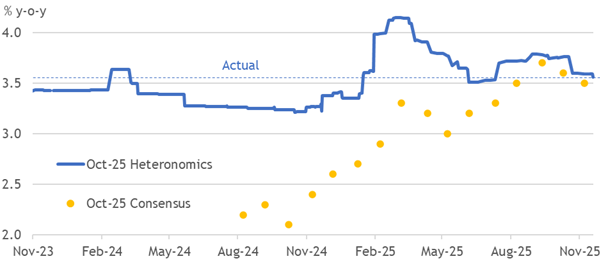This weekly newsletter pulls together summaries of the top ten most-read Insights across Macro and Cross Asset Strategy on Smartkarma.
Receive this weekly newsletter keeping 45k+ investors in the loop
1. 173: The End of US Equity Dominance? With Chris Wood, Global Strategist and Author of ‘Greed and …
- US stock market dependency on world index has increased significantly, reaching around 65-67%
- Tariffs implemented by Trump have had a bearish impact on stock market
- Small cap underperformance in US market is at its highest in 25 years, leading to interesting valuation opportunities
This content is sourced through publicly available sources and has been machine generated. Information displayed is for general informational purposes only.
2. UK: Spurious H1 Surge Again
- GDP’s resurgence caught the consensus off guard, as it failed to recognise the residual seasonality still skewing activity growth into the first half of the year.
- The 0.7% q-o-q outcome for Q1 matched our forecast and leaves a powerful carry-over to Q2, where GDP seems set to exceed the BoE’s 0.1% forecast at about 0.4% q-o-q.
- Strength discourages another policy rate cut. Disappointment in H2 is the hangover, but we doubt it will motivate renewed easing amid excessive price and wage inflation.
3. USD Bears Broke The Bandwagon
- Investors ask whether threats to the USD’s reserve currency status are resting or dead, whereas we wonder if it was ever alive. Commentators routinely overextend narratives.
- The USD share of allocated FX reserves is already trending downward. A potential acceleration from smaller deficits and higher tariffs would partly offset the impact.
- Fuller hedging of USD asset holdings abroad may have already reached its limit. We still see more attractive mispricing elsewhere, such as excessively dovish rate curves.
4. HEW: Dovish Arguments Ageing Poorly
- Equity and rates market prices normalised further as data remains too resilient to prompt cuts, and US trade policy still seems to be reversing its destructive aspects.
- UK GDP boomed beyond expectations again, albeit amid residual seasonality. US CPI data were soft and stable, as companies appeared to have smoothed the tariff shock.
- Next week’s UK inflation data could compound the pressure by exceeding the consensus to reach 3.4% on the CPI. The flash PMIs and RBA decision are other timely highlights.
5. 100 days later: are all countries emerging markets now?
- Bob Gilhooly, a senior emerging markets economist at Aberdeen, joins the podcast to discuss Trump’s first 100 days in office and his key outcomes
- Trump’s focus on trade deficits and tariffs has raised concerns about revenue raising and potential impact on the U.S. deficit
- Uncertainty surrounding trade negotiations and potential outcomes continues to be a key feature of Trump’s presidency
This content is sourced through publicly available sources and has been machine generated. Information displayed is for general informational purposes only.
6. Bitcoin, Buffett, and the Barbarians at the Gate | Ep. #020 – The New Barbarians Podcast
- Market experiencing steepening yield curve, potentially indicating higher inflation and stronger growth
- Stocks rallying, with significant moves in earnings yield and small caps
- Asia and Europe markets up, Dow, S&P, Nasdaq, and Russell all posting gains; Gold and Bitcoin down, Oil up, Vix down
This content is sourced through publicly available sources and has been machine generated. Information displayed is for general informational purposes only.
7. UK: Tax Not Breaking Cost Pressures
- Underlying unemployment rates are broadly stable, despite higher headline and underemployment rates, where the latter lacks relevance to disinflationary pressures.
- Activity levels are expanding healthily and redundancies fell in April, suggesting no substantial jobs impact from the NICs rise, contrary to dovish fears.
- Wage growth should slow to accommodate some of the tax cost increase, but there isn’t much evidence yet. Total pay growth is little changed in recent years.
8. Steno Signals #196 – What’s next for inflation given the US/China pause?
- On the heels of the US/China “pause” announcement in the trade war, here’s a quick take on market implications and what to watch next:The initial market reaction has probably been more muted than many anticipated.
- Bond yields ticked slightly higher, gold softened, and there were modest tailwinds for regions and countries previously hammered by tariff exposure following yesterday’s “deal” in Geneva.
- But beneath the surface, several dynamics warrant a closer look.
9. The Drill – When the Facts Change, So Do We
- Greetings from Copenhagen.
- The global macro landscape is shifting rapidly, with U.S. policy priorities evolving just as quickly.
- The administration is now 1) refocusing on the Middle East, 2) signaling that a Ukraine–Russia deal is inching closer, and 3) initiating currency policy discussions with Asian nations—many of which are active FX manipulators.
10. US Inflation Trends Stick Against Tariffs
- A marginal downside surprise in headline US inflation measures preserves uncomfortably excessive trends, even without a significant tariff shock and with ongoing airfare falls.
- Companies may have helpfully smoothed out the tariff shock such that volatile policy never hits consumers. Services (ex-shelter) continued to grow too rapidly for rate cuts.
- Being in the right ballpark of the target isn’t good enough when the labour market remains tight. At least core price and wage inflation in the US isn’t as bad as in the UK.


